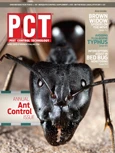Bed bugs are becoming an important urban pest in the U.S. as well as in Canada, Europe and Australia (Hwang et al. 2005, Gangloff-Kaufmann et al. 2006, Doggett et al. 2007, Potter et al. 2008). Their status as a highly important new urban pest will only intensify due to current lack of effective control tools, insecticide resistance and difficulty in detection. Both researchers and PCOs recognize that developing an effective bed bug monitoring tool is of the highest priority, if we are to curb the spread of bed bugs.
Researchers have experimented with sticky traps alone or in combination with heat or carbon dioxide attractant, but to date these have yielded minimal success (Cooper 2006). Bed bug detection dogs can detect live bed bugs and even viable eggs (Pfiester et al. 2008), but the cost and availability of well-trained dogs is prohibitive to most PCOs. As a result, time-consuming and tedious visual inspection is the only monitoring method available to most PCOs. While identifying signs of heavy bed bug infestations is relatively easy, low level infestations are difficult to find, and determining whether bed bugs are successfully eliminated after a control treatment has been applied is a daunting task.
An experimental interceptor. In search of an affordable and effective bed bug detection tool, we designed an interception device to be placed under furniture legs (see Figure 1 at right). It takes advantage of two bed bug behavioral characteristics: active searching for a human host upon which to feed and their tendency to climb vertical coarse surfaces. The interceptors are installed under legs of bed bug-infested sofas or beds. After installation, the furniture is pulled away from the wall to prevent bed bugs from accessing the furniture via walls or curtains. Through normal dispersal, bed bugs crawl into the interceptor and are trapped. Bed bugs attempting to enter the furniture fall into the space between the two plastic bowls where they are not able to escape because of the bowl’s hard, smooth surface. Bed bugs coming down from the furniture are killed by contact with the insecticide dust in the small bowl.
To determine whether the device can be used as a reliable tool for evaluating the efficacy of bed bug controls, we identified eight bed bug-infested apartments through visual inspection. We then applied bed bug management treatments consisting of hot steam, encasements to mattresses and box springs, and diatomaceous earth (MotherEarth D) as residual insecticide protection. Immediately after the treatment, interceptor devices were installed under each leg of the bed and/or sofa. Follow-up visual inspections were conducted after 2, 4, 6, 8 and 10 weeks. Live bed bugs were counted and were either removed using forceps or were killed with reapplications of hot steam. During each post-treatment bed bug inspection, bed bug interceptor devices were checked and numbers of bed bugs were recorded.
RESULTS. The average bed bug counts per apartment from visual inspections and interceptors (over a 10-week period) were 39 and 219, respectively (see Table 1 on page 118). The bed bug interceptors yielded nearly six times more bed bugs than visual inspections. Thus, interceptors were determined to be more effective than visual inspections in assessing bed bug numbers.
The large and small plastic bowls comprising the bed bug interception devices caught an average of 207 and 13 bed bugs in each apartment, respectively. This demonstrates that even careful treatments and visual inspections are relatively ineffective in killing or capturing all bed bugs, especially those bugs not on furniture.
A Commercial Interceptor. A commercial product, the Climbup Insect
Interceptor, (visit www.insect-interceptor.com) became available recently. It uses the same general principles as the experimental intercepting device except that talc powder is applied inside the interceptors to prevent escape. To test this product we compared visual inspection, resident awareness, and Climbup interceptors for detecting very light bed bug infestations. Thirteen apartments from a high-rise building that had previous bed bug infestations or that were adjacent to apartments with known infestations were selected for this study.
RESULTS. The inspections revealed that all 13 apartments were infested with bed bugs. The average bed bug count was 6.7 per apartment. Among the residents interviewed, only four of 10 said they noticed bed bug bites. After visual inspection and hand removal of bed bugs, we installed Climbup interceptors under furniture legs. After seven days, an average of 8.8 bed bugs per apartment was captured using the interceptors.
CONCLUSIONS.:Bed bug interceptors are more effective than visual inspections for determining the presence/absence of bed bugs and estimating bed bug numbers. In addition, they can effectively detect low levels of bed bug infestation. Because interceptors remove bed bugs, they also provide immediate relief to residents from bites and reduce the need for insecticide applications as they catch the bugs.
Wang is a researcher from Rutgers University Dept. of Entomology. Gibb and Bennett are with Purdue University’s Dept. of Entomology.
Acknowledgements: The authors thank Susan McKnight for providing the interceptors and input into designing the studies, Mahmoud Aboul El-Nour, Eva Chin, and Kurt Saltzmann for assisting in data collection.
Disclaimer: Brand name is used simply for clarity with the understanding that no discrimination is intended and no endorsement by Rutgers Cooperative Extension and Purdue University Cooperative Extension Service is implied.
References:
Cooper, R. 2006. Bed bugs – still more questions than answers: a need for research and public awareness. Amer. Entomol. 52: 111-112.
Doggett, S. 2007. A code of practice for the control of bed bug infestations in Australia. http://medent.usyd.edu.au/bedbug/bedbug_cop.htm.
Gangloff-Kaufmann, J., C. Hollingsworth, J. Hahn, L. Hansen, B. Kard, and M. Waldvogel. 2006. Bed bugs in America: A pest management industry survey. Amer. Entomol. 52: 105-106.
Hwang, S. W., T. J Svoboda, I. J. De Jong, K. J. Kabasele, and E. Gogosis 2005. Bed bug infestations in an urban environment. Emerg. Infect. Dis. 11: 533-538.
Pfiester, M., P. G. Koehler, and R. M. Pereira. 2008. Ability of bed bug-detecting canines to locate live bed bugs and viable bed bug eggs. J. Econ. Entomol. 101: 1389-1396.
Potter, M. F. 2008. The business of bed bugs. Pest Management Professional. 76(1): 24- 25, 28-32, 34, 36-40.

Explore the April 2009 Issue
Check out more from this issue and find your next story to read.
Latest from Pest Control Technology
- Moneypenny is a Provider of Virtual Receptionists
- Video: Top 10 PCT Photo Contest Finalists
- Massey Services Expands with Southeast Commercial Region
- Pest Management Foundation Announces Kevin J. Burns Scholarship
- How to Identify Clover Mites
- Termite Threat Halted in Southern Florida
- PCT Media Group Adds Managing Editor Katie Hobbins
- Evens Clerjuste on Team Communication as Company Growth Point





